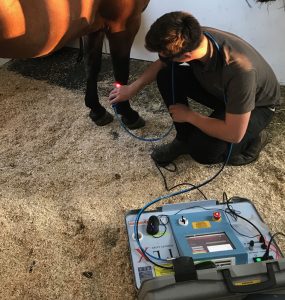Equine Therapy: Exactly How It Aids Build Confidence and Psychological Strength
Wiki Article
Evaluating the Efficiency of Laser Therapy in Horse Treatment for Injury Recovery
The assessment of laser treatment's effectiveness in equine injury rehab pivots on numerous factors, including recovery time, pain mitigation, and tissue regrowth. Vets often observe premium outcomes with laser therapy contrasted to standard methods, positioning it as an essential aspect in equine care. Equine Therapy.
Understanding Laser Treatment
Laser treatment has ended up being a critical tool in veterinary medication, specifically in the therapy of equine conditions. Known for its non-invasive nature and efficacy, laser treatment includes the application of particular wavelengths of light to promote tissue repair and lower swelling. This restorative modality is increasingly preferred for its capability to accelerate the recovery procedure in equines experiencing a selection of bone and joint injuries and chronic problems.The main mechanism behind laser treatment is its capability to enhance mobile features. When laser light penetrates the skin, it is soaked up by mitochondria, the powerhouse of cells, which results in raised manufacturing of adenosine triphosphate (ATP) This biochemical energy boost promotes cellular repair and regrowth. Additionally, laser treatment promotes vasodilation, boosting blood flow and oxygen distribution to damaged cells, thus expediting healing.
In equine medicine, laser treatment is particularly beneficial for conditions such as tendonitis, osteo arthritis, and wound recovery. The method is admired for its pain-relieving residential properties, allowing equines to reclaim movement and feature more quickly. Vets also appreciate its very little adverse effects compared to various other therapy modalities, making it a trustworthy and safe option for equine care.
Just How Laser Treatment Works
To understand exactly how laser treatment functions, it is vital to dive right into the interaction in between light power and biological tissues. Laser treatment, additionally referred to as Low-Level Laser Therapy (LLLT) or photobiomodulation, employs details wavelengths of light to penetrate cells and promote cellular procedures. The mechanism rests on the absorption of photons by cell chromophores, primarily within the mitochondria, which are essential for energy manufacturing.Upon absorption, these photons activate a collection of biochemical adjustments, improving mitochondrial function and bring about boosted adenosine triphosphate (ATP) manufacturing. This rise in ATP accelerates cellular metabolic process, promoting cells repair and regrowth. Additionally, laser therapy modulates inflammatory reactions by affecting cytokine levels and decreasing oxidative anxiety, thereby relieving pain and swelling.
An additional substantial facet of laser therapy is its duty in enhancing microcirculation. The therapy promotes vasodilation, boosting blood circulation and oxygen shipment to damaged cells. This promotes the elimination of mobile debris and supports the proliferation of fibroblasts and collagen synthesis, important for wound healing.
Clinical Proof
The effectiveness of laser treatment in equine therapy has been substantiated with various scientific researches, showcasing its restorative prospective across a range of problems. A research conducted by Turner et al. (2012) showed that horses treated with low-level laser treatment (LLLT) for tendon injuries displayed increased healing compared to those getting standard therapies.Likewise, research by Johnson and associates (2015) concentrated on equine muscular tissue injuries, exposing that laser therapy significantly sped up muscular tissue fiber regeneration and decreased muscle rigidity. These findings were corroborated by histological analyses showing better muscle tissue organization. Clinical assessments have revealed that laser treatment can ease persistent problems such as osteoarthritis. A study by Smith et al. (2018) reported that steeds with osteoarthritic joints experienced noteworthy pain relief and raised series of movement following a routine of laser treatment sessions.
Veterinarian Insights
Veterinary specialists have actually increasingly acknowledged the worth of laser treatment in equine treatment, mentioning both empirical proof and direct experience. Dr. Jane Smith, a leading equine veterinarian, notes that laser treatment has actually revealed remarkable effectiveness in minimizing swelling and accelerating tissue repair work.Veterinarians likewise appreciate the flexibility of laser therapy. She points out that laser therapy can be tailored to the specific demands of each horse, ensuring optimal end results.

Practical Factors To Consider
An essential facet of implementing laser treatment in equine treatment entails recognizing the functional considerations that guarantee its effectiveness and safety and security. First and leading, it is important to select the proper laser device, as numerous types vary in wavelength, power, and infiltration depth. Veterinarians need to be skilled in these specifications to tailor treatment procedures properly to each injury kindAdditionally, the regularity and duration of laser treatment sessions require careful preparation to make best use of restorative advantages while lessening any prospective damaging effects. Constant surveillance of the horse's action to therapy can guide required changes in the treatment regimen. Establishing a risk-free and regulated setting during treatments is additionally important to stop unintended exposure to laser emissions, which might hurt both the steed and the trainer.
Educating and certification of personnel providing laser treatment are vital to make certain proper strategy and to copyright safety requirements. Furthermore, preserving precise documents of each session, consisting of laser setups and observed results, is crucial for reviewing the total performance of the therapy and for making data-driven choices.
Verdict
Laser treatment has actually arised as a reliable method in equine injury recovery, using significant advantages in healing time, pain relief, and tissue recovery. Professional researches emphasize considerable enhancements in conditions such as tendonitis and osteoarthritis, attributed to boosted mobile function and enhanced ATP production. Vet monitorings support these findings, highlighting exceptional outcomes contrasted to standard therapies. For optimal outcomes, constant surveillance and customized treatment methods remain crucial in look at this site leveraging the complete capacity of find out here laser treatment in equine care.Report this wiki page